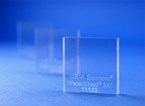DSM Somos WaterShed XC 11122 Passes USP Class VI Testing: Now Suitable For Prototyping In Biomedical Or Skin Contact Applications

DSM Somos, a world leader in the development of advanced stereolithography (SL) materials recently announced USP Class VI approval for their WaterShed XC 11122 resin-a clear, water-resistant material already widely used in the medical device industry. The classification officially approves the resin for use in a wide range of biomedical or skin contact applications.
Developing advanced biocompatible SL resins for the medical industry is becoming increasingly important. According to Wohler's Report 2008, the medical/dental industry is the third largest industry for additive manufacturing after consumer products/electronics and automotive, but growing at a faster rate than either.
"Due to its functional properties and high dimensional stability, WaterShed XC has already been widely used in the medical industry for prototyping clear medical device housings and fluid flow analysis models," says DSM Somos Product Manager Brian Bauman. "The new USP Class VI approval now opens up new applications, including prototypes to be used in clinical trials."
Introduced by DSM Somos in 2007, WaterShed XC has quickly become the best-selling clear SL resin on the market, with its winning combination of clarity, durability and high dimensional stability. By adding the biocompatibility component, medical design engineers now have a way to produce exceptional ABS-like prototypes that are USP Class VI approved.
About USP Class VI Materials: United States Pharmacopeia (USP) XIX biological tests are designed to provide information on potential biological effects of polymer materials. One of six different classes (I-VI) are assigned to a material, depending on its performance in biological tests. The higher the material class, the more severe and stringent are the tests. WaterShed XC 11122 has passed the most severe test requirements in order to be qualified as a USP XIX Class VI material. NOTE: Special cleaning procedures must be used for SL parts used in USP Class VI applications. Contact a DSM Somos representative to learn more.
About DSM Somos Materials
What is stereolithography?
Stereolithography (SL) permits the rapid creation of 3D pieces utilizing a computer-controlled laser that polymerizes light-sensitive resins. The process is highly precise and constructs the object in a series of "additive layers," providing the advantage of producing highly complex forms that are difficult or impossible to fabricate by machining or traditional molding techniques. The evolution of advanced SL materials offers the potential of moving stereolithography from prototyping into direct manufacturing.
DSM Somos ProtoCompositesT are resins reinforced with various materials, such as ceramics and glasses, to produce functional properties not possible using individual components. Somos ProtoComposite materials are the result of a significant research and development program investigating the potential for ACT-SL (Advanced Composite Technology for StereoLithography). In 2003, DSM Somos introduced ProtoToolT 20L as the first ceramic-filled resin in its line of ProtoComposites. Since then, two additional composite resins have been added to the line: NanoFormT 15120 and Somos NanoToolT.
DSM Somos ProtoFunctional resins for stereolithography provide advanced technology to respond to the changing needs of new product development and industrial design. Traditional non-composite ProtoFunctional materials by DSM Somos demonstrate a varying range of performance properties including: transparency, superior humidity and heat resistance, and mechanical properties which replicate those of many production grade plastics such as polypropylene, polyethylene, ABS and PBT. Technical data on all Somos materials may be found at www.dsmsomos.com
SOURCE: DSM Somos
